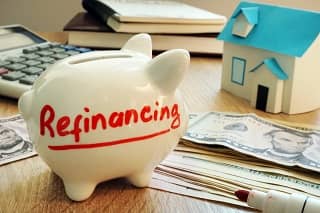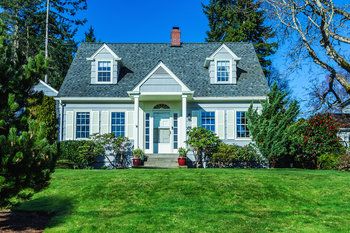 When you buy or refinance a home, there are a number of loan types available. From government-backed FHA and VA loans, to conventional fixed-rate 15, 20 or 30-year loans, there's no shortage of options.
When you buy or refinance a home, there are a number of loan types available. From government-backed FHA and VA loans, to conventional fixed-rate 15, 20 or 30-year loans, there's no shortage of options.
One important consideration is whether to go with a fixed-rate or an adjustable-rate mortgage (ARM).
Why homeowners choose to refinance into an ARM
Adjustable-rate mortgages were problematic for some homeowners during the housing market crash of more than a decade ago. During that time, ARMs (which carry lower initial interest rates) helped get a borrowers' payments where they needed to be to qualify for loans.
When the interest rate adjusted, borrowers with a higher interest rate sometimes found they couldn't afford the new higher payment. This brought many banks' lending practices under scrutiny.
Fortunately, thanks to tighter lending guidelines, times have changed. Since ARMs tend to have lower initial interest rates than their traditional 30-year fixed-rate counterparts, ARM refinances are especially popular when mortgage rates begin to rise and consumers need a lower-cost option.
Here are times when ARM can make sense:
1. Lower mortgage rates are desired: Depending on a number of factors, ARM interest rates are often lower than today's mortgage rates for 15, 20 and 30-year fixed-rate loans.
2. Soon-to-be home sellers enjoy low rates now: "If you know you're nearing the time that you are most likely to be selling your home, an ARM can be a great loan," says Jackie Peck, a Branch Manager with Acopia Home Loans in Atlanta, Georgia.
Peck adds, "Some people know for sure that they are going to be moving to another home within a few years, or they know they're probably going to refinance out to a new loan sometime soon. In either case, it could make sense to save more money, and pay more towards your principal, all thanks to the lower rate that may come with the ARM."
3. Improve your financial standing: Keith Gumbinger, vice president of HSH.com, says another candidate for an ARM refinance is a homeowner who is waiting for their personal finances to improve. For this kind of homeowner, an adjustable rate mortgage provides valuable short-term stability. "This can be a great product to tide you over for a few years as long as you save money while you are using an ARM," says Gumbinger.
Why are ARM mortgage rates lower?
"With short fixed-rate periods, lenders take on far less interest-rate risk when making ARMs than when they write long-term fixed-rate mortgages," explains Gumbinger. "Although it depends upon the ARM as well as market conditions, ARMs tend to have lower interest rates than 30-year fixed-rate mortgages.
Unlike most fixed-rate mortgages, which are sold to others, lenders also find ARMs to be desirable and profitable additions to their own loan portfolios, so they may price these aggressively at times in order to capture business."
How are adjustable rate mortgage rates determined?
ARMs start out with a fixed-rate period, often one, three, five, seven or 10 years. During this initial loan period, the ARM is essentially a short-term fixed-rate loan. ARMs with longer fixed-rate periods typically have slightly higher mortgage rates ,notes Gumbinger.
After the fixed period, the mortgage rate adjusts according to the loan terms. In the case of a 5/1, the ARM can reset every year following the five year fixed-rate term. One of the major determinants to the adjusted interest rate is the index to which the mortgage is linked.
For example, if at the time of adjustment, the index interest rate is 4% and your margin is 2%, the lender adds them together to arrive at a 6% interest rate for your loan.
"Most new ARMs are adjusted according to SOFR (Secured Overnight Financing Rate) and some are adjusted according to Treasury securities, both of which are influences by the economy and by Federal Reserve decisions," explains Gumbinger. "Studies have shown that final mortgage rates for loans tied to these indexes end up in about the same place over time, but borrowers should be sure to ask about the index and understand how it works."
Should I refinance into an adjustable rate mortgage?
While an ARM mortgage can save you money, the risks are also clear -- if and when your interest rate rises, it's possible that your payments could increase.
If your monthly payments when the initial fixed-rate period ends might put a strain on your budget, an ARM probably isn't the best choice for you.
Before taking out an ARM, be sure to get a Loan Estimate disclosure from your lender. This document should list the maximum amount your monthly mortgage payment could reach. Make sure you're comfortable with this amount before you sign up for an ARM.
But there are times when an ARM is a smart choice.
Starting interest rates on ARMs are usually lower than on fixed-rate mortgages, so your monthly payments are likely to be lower for at least a few years. And, if you should find yourself in an environment where mortgage interest rates are declining or holding steady, your interest rates may not increase significantly even after the fixed-rate period is up, or a chance to refinance may even present itself.
Even though the spread between a 30-year fixed mortgage and an ARM isn't what it was several years ago, an ARM mortgage may still be worthwhile. Here's a potential savings example when comparing a 7-year ARM rate to a 30-year rate that is .25% lower on a loan amount of $300,000.
|
Term |
Rate |
Payment |
|
30-year fixed |
6.50% |
$1,896 |
|
7/1 ARM |
6.25% |
$1,847 |
That's a savings of $49 per month on your mortgage payment, and a seven year savings of $5,268; plus, the lower rate on the 7/1 ARM will see you retire $1,148 more principal over that time, too.
Final advice on ARM mortgages
Before you sign up for an ARM, it's important to calculate how much your mortgage payment could change over the lifetime of your loan to make sure it's still something you can afford. It's not difficult to do some "what ifs?" where interest rates change just a little or move up quite a bit.
If you're getting into an ARM with an eye toward refinancing before it comes to its first adjustment, it is important to be confident that you will remain in your home for at least a few years after refinancing. Even if you're expecting to see considerable savings over time from a refinance, closing costs can easily erase a lot of them, so be certain to factor these into your refinance decision, and that you'll likely be there to actually get the savings you are after. Otherwise, it might end up being better to just hold onto the ARM, even if monthly payments are higher for a time.
You may want to consider an ARM if you:
- May sell or refinance the house in five years, seven years -- or however long you have before the rate starts adjusting
- Expect your income to rise enough to absorb higher mortgage payments
- Think interest rates are likely to decrease when your ARM is due to reset
In the end, an ARM may be better if you can enjoy the low interest rate at the start of the loan and sell your home, refinance, or pay off the mortgage before the loan has the potential to get more expensive.
To learn about how ARMs work and who they might work best for, check out HSH's comprehensive Guide to Adjustable Rate Mortgages.
This article was revised by Keith Gumbinger.



